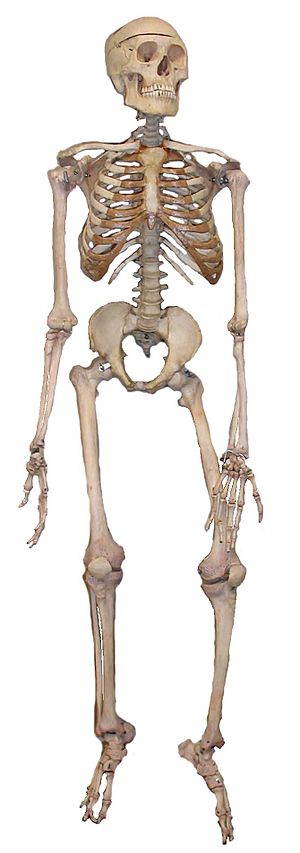 Image via Wikipedia
Image via WikipediaBasic Tips for Zhan Zhuang and the pelvis
There has been some talk recently about a couple of the posts put up on this blog. These two articles are: “Keys for developing the inguinal crease” which is about the Wujifa “Side to Side” practice and the other “Concepts of sit down in Wujifa standing." Both in standing practice(s), what some call Zhan Zhuang, and the side to side practice(s), which are basic keys for developing the connections that many martial arts seek as well as those who practice certain types of qigongs and some forms of yoga.
The first point I’d like to share is that many people carry a lot of tension in the glutes or more simply said the butt muscles. When people have a normalized patterning of tension that is carried in the glutes you will find that the femoral heads are pulled back and twisting the legs so they often stand in daily life with their toes angled slightly outward. The second pointer is also very common in so many people and that is the muscles found in the lower back area are shortened and tight. Some of these seemingly normal imbalances are found in these muscles and fascial groups: Erector spinae, Thoracolumbar fascia, Latlissimus dorsi muscle, Petlit’s, Gluteal aponeurosis, Quadratus lumborum, Psoas, just to name a few.
When one simply relaxes more deeply or as one learns to relax the muscles of the lower back and supporting muscles and relax the glutes while practicing stance training then the back can lengthen and the femoral heads of the right and left legs can be allowed to widen. This gives more room for the pelvis to adjust on the hip joints and with the opening/lengthening of the spine “allows” the tailbone or sacrum to shift and drop downward in these practices. This is VERY different than tucking.
Many people try to lengthen the back by tucking the pelvis. That may be a method used in some practices that use force and tightening as a method although I am not going to comment on those. As for others they may not understand how to relax and maintain structure without being limp and so they feel the need to create some type of tension to maintain these structures. So, they tuck the tail bone and use opposing muscles to counteract the tightness in the lower back and glutes with even more tightness and muscle. As they are simply trying to achieve an outward look of a practice with a conflicting set of tightness and contraction which will normalize and create even more rigidness.
What we aim for in the Wujifa standing practice skill set is to repattern or build in a more open responsive posture. We do this in learning to relax and adjust accordingly. Often is the case found in hip adjustments and relaxing the glutes and lower back muscles so the pelvis can shift and adjust to a more functional space for example in the standing practices.
Hopefully sharing some of this the information may be insightful to the readers here. Saying that, I would like to share a simple method for helping one allow a better structure in their practices to shift and develop as they train Zhan Zhang, Wujifa standing, other internal martial art or qigong practices as they may apply.
Stand up, and take a deep breath. Go ahead try this now. Wiggle around a bit as this can help you access the lower back and hip area. Now take another deep breath and as you exhale relax the butt muscles and lower back muscles. Allow the hip area to widen and the lower back to lengthen as you get more in touch with the tightness that has started to release. Feel how there is a more groundedness showing up and how there is less conflict between the muscles. This is a good place for the beginner to play. As one practices a deeper awareness will develop. You could look at that as a basic philosophy that some talk about in ideas such as Taoism. This is one of the basic keys in starting to understand more of what we train and call Wujifa and the standing practices and side to side skill sets.

Hopefully you’ve noticed some “basic” differences between using forceful tucking and the practice of opening to allow shifting to take place. Simply by widening the femoral heads, relaxing the glutes, and allowing the back to lengthen you will start to notice how the posture can be guided into the more formal structure of a stance practice as utilized for example in Wujifa. This is a good place to start. The study of Wujifa stance and other practices may seem simple yet are very deep. Developing alignment and body and fascial connections and understandings are key for making good progress. We will write more on this subject in the coming weeks. Until then remember the key is in the doing. Check back often and ask questions and comment. Feel free to contact us!
Also check out: More on Zhan Zhuang and Movement
As with any exercise, make sure you are in good enough physical health before attempting this. Ask a doctor if in doubt.
Also check out: Zhan Zhuang Alignment
Also check out: Wujifa Two Feet and What Does This Mean?
Also check out: Keys for Developing the Inguinal Crease, aka Kua, with Wujifa Side to Side Practice
Also check out: The Concept of "Sit Down" in Wujifa Standing...





